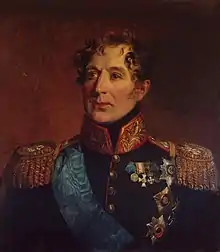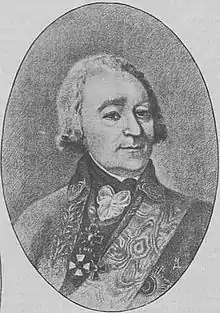Miloradović noble family
The Miloradović (Serbian Cyrillic: Милорадовић) or Hrabren (Храбрен) or later Stjepanović (Стјепановић),[a] were a Eastern Orthodox Vlach noble family and a katun clan from Hum, parts of present-day of Herzegovina,.[5][6][7][8][9][10][11][12][1][4][13] whose some later branches embraced Serb ethnic identity,[14] while other converted to Islam.[9] The members of the family served the Kingdom of Bosnia, Republic of Ragusa, Ottoman Empire.[1]
| Miloradović Hrabren | |
|---|---|
| noble family | |
 Radimlja necropolis, resting place for several members of the family, is National Monuments of Bosnia and Herzegovina and inscribed UNESCO heritage site. | |
| Parent house | Hrabren |
| Country | Bosnia and Herzegovina |
| Place of origin | Donji Vlasi Dubrave, Vidovo Polje (region surrounding Stolac) |
| Founded | mid-14th century |
| Founder | Milorad |
| Titles | vojvoda (duke), knez (count) [1][2] |
| Members | duke Stipan Miloradović duke Petar, son of duke Stipan |
| Connected families | Hrabren, Stjepanović |
| Estate(s) | manors in Crnići, Dubrave, and Opijači property in Žitomislić, Dračevo and Svitava, Gabela, by the river Neretva |
Middle Ages
It is deduced from written monuments the progenitor of Hrabren-Miloradović family was probably chieftain of Vlachs from Donji Vlasi,[1] Milorad Hrabren, who lived in the second half of 14th century. In 1416 is mentioned his son, Stipan, in appeal by Republic of Ragusa due to fighting along Petar Pavlović, a magnate of the Kingdom of Bosnia against Sandalj Hranić and Ottomans in the Lower Neretva near Slivno.[13][15] He had three sons: Petar Stjepanović is first mentioned in 1473 and last time in 1486, Radoja Stjepanović died between 1475–1477, while Vukić Stjepanović was mentioned for last time in 1496.[15] They had lands between Stolac and Mostar.[16][17]
Radimlja, near Stolac, was in their possession, and the famous graveyard with stećci there was most likely the clan's burial ground, as number of family members, at least five, have been buried there.[18][19] There are epitaphs on five medieval stećak referring to the Miloradović family.[17]
Ottoman period
During the Ottoman period,[20] some members of the family were Christian sipahis.[21] As Ottoman subjects, they were given privileges and possessions, where they founded churches.[16] The various family members in various times erected four of such buildings: the Church of Peter and Paul in Ošanići was built prior to 1505, its founder was duke Radoslav,[1] the Church of St. Nicholas in Trijebanjj, 15 km from the town of Stolac, is erected in 1534 as an endowment of duke Radoje Hrabren,[22] in Klepci the Church of the Transfiguration of Christ (St Luke), built by sipahi Milisav Hrabren-Miloradović most likely close to the end of the 16th century,[23] and the Žitomislić monastery 1566 by duke Petar and his brother Ivan (with the Church of the Holy Annunciation in 1603).[3][12][24]
The katun formation by Petar and Vukić Hrabren was part of the Vlach group Donji Vlasi (Lower Vlachs) of nahiye Blagaj - and their katun was the largest with 127 houses and 16 unmarried persons out of 37 katuns, 1383 houses and 177 unmarried persons. At the time Petar Stjepanovič-Hrabren along knezes Vukac, Pavko, Stipan and Radivoj Popratović was included in the order of Ragusan citizens, as well was Ottoman timariot.[17]
When the Ottoman feudal system, which they were part of, started falling apart in Herzegovina in the 16th and 17th centuries, the clan started dispersing itself as they felt unsafe.[25] The Miloradovići in Dubrava remained in Ottoman service as sipahi with the Sultan's grant until the mid-17th century, when more Ottomanized nobility which had the ruling power pushed them aside.[26] Those members of Miloradović-Stjepanović who remained in Žitomislić have taken collective surname Ljoljić and Kuzman, while those who converted to Islam have taken surname Opijač and today live in Dubrava near Stolac. From the Dubrava family, Jeronim Miloradović-Hrabren became an Austrian officer in the 18th century.[27]
Miloradovich family in the Russian Empire
Since the 17th century some Miloradović members migrated to Russia, with occasional visits to Herzegovina carrying gifts and Church books.[28] Mihailo Miloradović (ca. 1650–1725) and Metropolitan Danilo I Petrović-Njegoš had been recruited by Peter I of Russia to incite rebellion in Herzegovina against the Ottomans in 1710–11 (during the Pruth River Campaign), but after unsuccessful attempts Mihailo was forced to flee Herzegovina to Little Russia where he joined Peter's service as a colonel.[29] Among Mihailo's descendants and prominent members of this branch include his grandson Andrei Miloradovich (1726–1796), a governor, and most importantly Mikhail Miloradovich (1771–1825), a Russian general prominent during the Napoleonic Wars.[28] Count Grigorije Miloradović-Hrabren (1839–1905), a Russian colonel, visited manastir Žitomislić in 1883.[27]
 General Mikhail Miloradovich.
General Mikhail Miloradovich. General Andrei Miloradovich.
General Andrei Miloradovich.
Legacy
Most important cultural and religious legacy of Hrabren-Miloradović are Radimlja family cemetery near Stolac,[4] three churches, church in Klepci the end of the 16th century, 1505 church in Ošanići, 1534 church in Trijebanj, and the monastery from the second half of the 16th and the beginning of the 17th century in Žitomislić.[23][22][1][3] Family members who emigrated to Russia rose to prominence, as high-ranking Imperial army officials.[30]
Annotations
- ^ Name: They are sometimes known in modern historiography by the combination of "Miloradovići-Hrabreni" (Милорадовићи-Храбрени) or "Hrabreni-Miloradovići" (Храбрени-Милорадовићи). The name Hrabren is derived from hrabar, meaning "brave".[31] The surname Miloradović is derived from Milorad Hrabren. During the Ottoman period, they were mostly known as Hrabren.
References
- Ljiljana Ševo; Tina Wik; Dubravko Lovrenović; Amra Hadžimuhamedović; Zeynep Ahunbay (27 January 2003). "St. Peter and Paul's Church, with the cemetery, judicial chairs, courtyard and walls in Ošanići, the historic ensemble". old.kons.gov.ba (in English and Serbo-Croatian). Sarajevo: Commission to preserve national monuments of Bosnia and Herzegovina. Retrieved 4 May 2020.
- Neco Sipovac (1977). Zapisi o zemlji. NISP "Oslobodjenje".
У дубровачким повељама за њих се вежу титуле војвода и жупана много прије доласка Турака. Велике камене судачке сто- лице, са којих су Храбрени - Милорадовићи судили својим не- послушним поданицима, ...
- Ljiljana Ševo; Tina Wik; Dubravko Lovrenović; Amra Hadžimuhamedović; Zeynep Ahunbay (11 November 2002). "Manastir Žitomislić, mjesto i ostaci graditeljske cjeline". old.kons.gov.ba (in Serbo-Croatian and English). sssssss: Commission to preserve national monuments of Bosnia and Herzegovina. Retrieved 4 May 2020.
- Ljiljana Ševo; Tina Wik; Dubravko Lovrenović; Amra Hadžimuhamedović; Zeynep Ahunbay (11 November 2002). "Necropolis of stecci at Radimlja, the historic site". old.kons.gov.ba (in English and Serbo-Croatian). Sarajevo: Commission to preserve national monuments of Bosnia and Herzegovina. Retrieved 4 May 2020.
- Fine, John V. A. (1994). The Late Medieval Balkans: A Critical Survey from the Late Twelfth Century to the Ottoman Conquest. University of Michigan Press. p. 487. ISBN 978-0-472-08260-5. Retrieved 4 May 2020.
- "Glasnik Zemaljskog Muzeja u Sarajevu, Nova Serija, Sv. VII (1952), VIII (1953), IX (1954), X (1955), XI (1956)" (PDF). Historijski zbornik (in Serbo-Croatian). Školska knjiga. IX (1–4): 234–235. 1956.
- Vego, Marko (1957). Naselja bosanske srednjovjekovne države (in Serbo-Croatian). Sarajevo: Svjetlost. pp. 127–129.
- Bešlagić, Šefik (1971). Stećci i njihova umjetnost (in Serbo-Croatian). Zavod za izdavanje udžbenika. p. 101.
- Lovrenović, Dubravko (2013). Stećci: Bosansko i humsko mramorje srednjeg vijeka [Stećci: Bosnian and Hum marbles from Middle Age] (in Serbo-Croatian). Ljevak. pp. 72, 225–231. ISBN 9789533035468.
- Marković, Mirko (1998). Descriptio Bosnae & Hercegovinae: Bosna i Hercegovina na starim zemljovidima (in Serbo-Croatian). AGM. pp. 49, 52. ISBN 9531740917.
- Ančić, Mladen (2005). "Kasnosrednjovjekovni Stolac". Historical contributions (in Serbo-Croatian). 29 (29): 51, 57.
- Hannes Grandits (2008). Herrschaft und Loyalität in der spätosmanischen Gesellschaft: das Beispiel der multikonfessionellen Herzegowina. Böhlau Verlag Wien. pp. 263–266. ISBN 978-3-205-77802-8.
- Marko Vego (1973). "Kulturni karakter nekropole Radimlje kod Stoca / Cultural character of the Radimlje necropolis near Stolac". in Radovi sa Simpozijuma Srednjovekovna Bosna i evropska kultura (in Serbo-Croatian) (Museum of Zenica III ed.). Zenica: Muzej grada. pp. 301–332. Retrieved 4 May 2020.
- Ljubo Mihić (1975). Ljubinje sa okolinom. Dragan Srnic. pp. 145, 151.
Прије свега, Храбрени-Милорадовићи су чисти Словени и то по националности Срби. Према томе, у пословној књизи дубровачког трговца и властелина Џивана Припчиновића, за период 1456—1479 године, ријеч влах за људе ноЈи се баве гајењем стоне, кано их он назива „влаха" натунара. Милорадовићи-Храбрени су себе сматрали Србима што се види из њихових изјава из манастирсних записа, из енцинлопедије, њихових православних богомоља, које су градили по Херцеговини.
- Lovrenović 2013, p. 225.
- Aleksandr Fedorovič Gil'ferding (1972). Poězdka po Gercegovině, Bosnii i Staroj Serbii. Veselin Masleša. p. 65.
Милорадовићи-Храбрени имали су посједе око Стоца и Мостара и били су у служби Павловића (Раденовића). Турци су им као савезницима оставили при- вилегије и посједе, на којима су Милорадовнћи изградили задужбине.
- Lovrenović 2013, p. 226.
- Милијана Окиљ; Dajana Samardžić (2005). Васкрс Житомислића. Бесједа. p. 26.
- Bulletin du Museé de la République populaire de Bosnie et Herzégovine à Sarajevo. 1952.
Што се тиче самога краја гдје су Милорадовићи-Храбрени имали своје феудалне домене, а то иде у прилог тврдњи да је некропола на Радимљи породично гробље Милорадовића, навешћемо још неке податке.
- Petar N. Gaković (1939). Bosna vilajet. pisac. p. 31.
Милорадовићи — Храбрени
- Milenko S. Filipović; Ljubo Mićević (1959). Popovo u Herzegovini: antropogeografski prikaz. Naučno društvo NR Bosne i Hercegovine. p. 59.
Много је значајније завођење новог друштвеног поретка и имо- винских односа према турском државном праву. Нема података да је у самом Попову било хришћанских спахија, као што су били напр. Храбрени-Милорадовићи у ...
- Ljiljana Ševo; Tina Wik; Dubravko Lovrenović; Amra Hadžimuhamedović; Zeynep Ahunbay (25 February 2003). "St. Nicholas Church in Trijebanj, the architectural ensemble". old.kons.gov.ba (in English and Serbo-Croatian). Sarajevo: Commission to preserve national monuments of Bosnia and Herzegovina. Retrieved 4 May 2020.
- Ljiljana Ševo; Tina Wik; Dubravko Lovrenović; Amra Hadžimuhamedović; Zeynep Ahunbay (9 October 2003). "Church of the Transfiguration of Christ in Klepci, school building and burial ground, the site and remains of the architectural ensemble". old.kons.gov.ba (in English and Serbo-Croatian). Sarajevo: Commission to preserve national monuments of Bosnia and Herzegovina. Retrieved 4 May 2020.
- Srpska pravoslavna crkva. Sveti arhijerejski sinod (1967). Službeni list Srpske pravoslavne crkve. 48. p. 137.
- Dušan Nedeljković (1929). O psihičkom tipu Južnosrbijanaca. 59. Državna štamparija.
Када се крајем XVI и XVII вијека почео распадати, у Херцего- вини турски феудални систем у коме су Милорадавићи-Храбрени има- ли повлашћен положај, они су се осјетили иесигурним, ради чега су се почели расељавати.
- Glasnik Srpskoga učenog društva. 40. 1874. p. 66.
Храбрени у Дубравама у садашњој столачкој нахији остали су, као спахије са султанским бератом до половине 17 вијека. На пошљетку притијешњени од више потурчене властеле, која је имала сву власт у рукама, замијене своје ...
- Lovrenović 2013, p. 230–231.
- Lovrenović 2013, p. 231.
- Schultz, C. C. (2004). "A Russian Bayard" (PDF). Archived from the original on January 12, 2006. Retrieved 2015-05-20.CS1 maint: bot: original URL status unknown (link). Taleon Club Magazine, 2004 no. 8. Retrieved 2011-07-16. Archived from the original on 2006-01-12.
- Atlagić, M. (2008). "Neke značajnije srpske plemićke porodice u BiH i njihovi grbovi" (PDF). Baština (24): 127–151.
- Glasnik Zemaljskog muzeja u Bosni i Hercegovini. Zemaljska štamparija. 1935.
Further reading
- Bogičević, V. (1952). Vlastela porodice Miloradovića - Hrabrenih. Sarajevo.